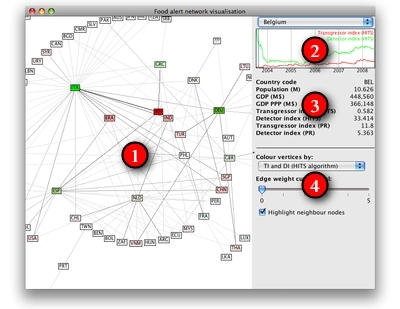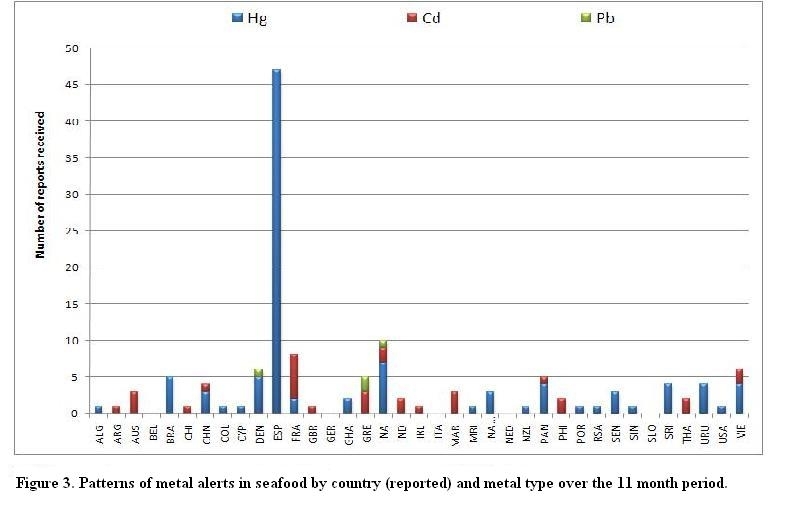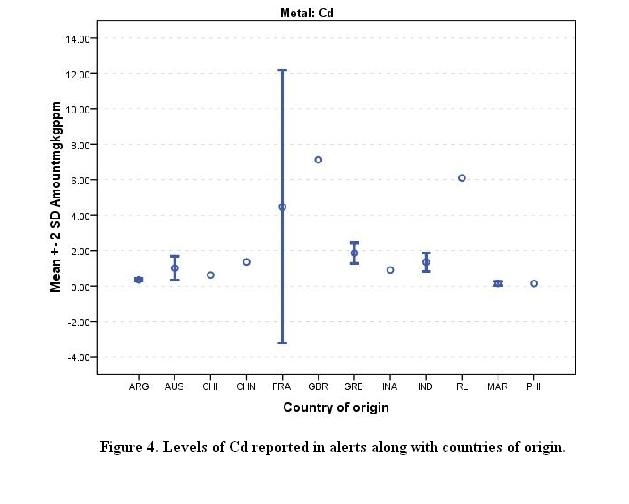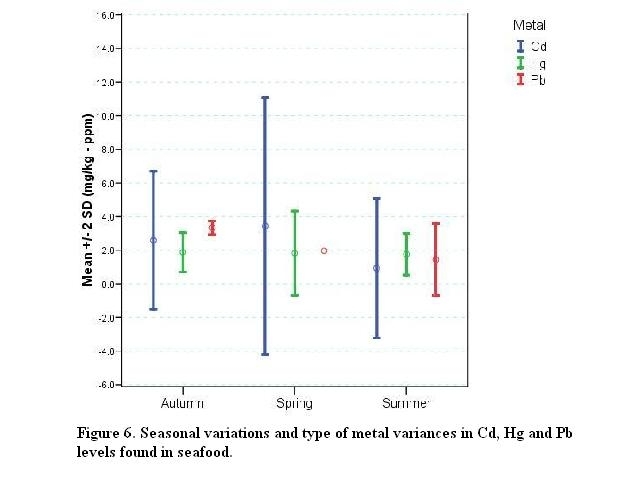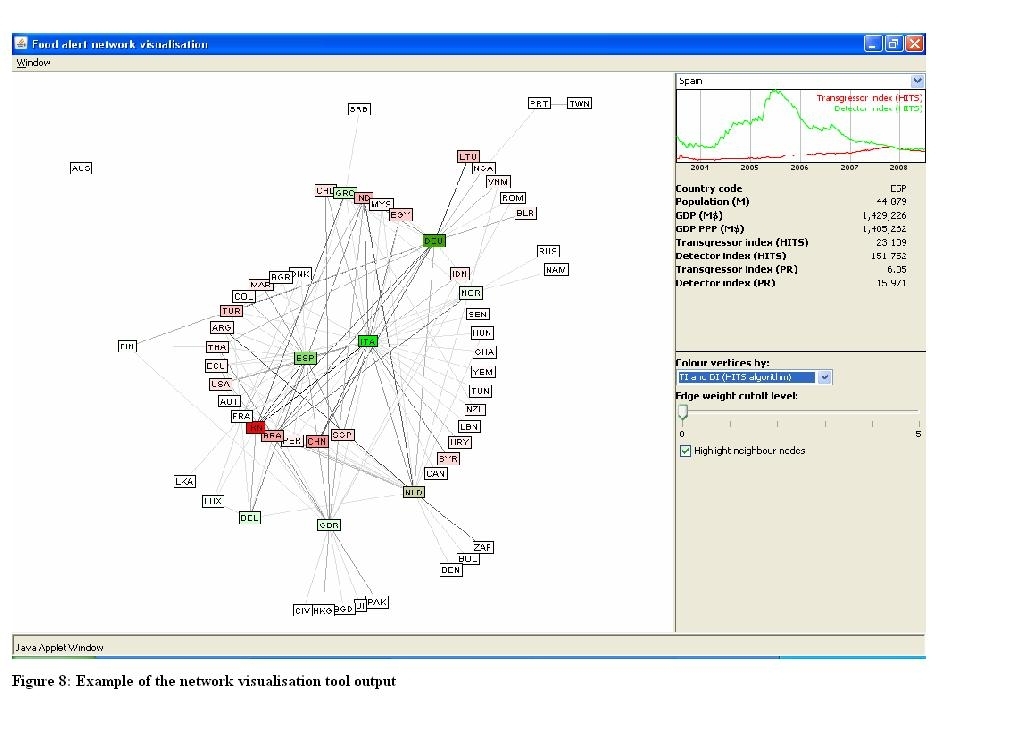Network approach to investigate food alert patterns for metal contamination analyses in seafoods
Enhanced global food safety requirements resulting from the globalization of food supplies are being met in a regional approach which defies the construction of a coherent rationale worldwide solution. The Beijing Declaration on Food Safety[1], instituted during the WHO Forum in 2007, was rapidly adopted by over 50 countries. These signatory nations promised to “establish food safety authorities […] within a comprehensive production-to-consumption legislative framework” for the protection of their citizens. However, recent studies reveal many inadequacies of global security systems. There are several key impediments to the initiation and establishment of food security programs for many developed and developing countries. These include a paucity of refined data on trends and patterns of food contamination by a range of health compromising agents such as infectious diseases, poisons, pollutants, heavy metals and carcinogens. Without suitable intelligence it becomes elaborately difficult for a nation to attain an efficient and effective food safety program. Moreover, from a overseer viewpoint, the systems adopted by large organizations (e.g. EU and USA) are far from compatible which presents challenges in data mining and manipulation in order to develop early warning systems or forecasting tools to empower agencies in order to prevent consumption of contaminated food and feed. Changes in global food supplies have necessitated intervention through modern approaches to maintain worldwide food safety and human health as identified by the Beijing Declaration.
Contents
Global scale of food security
With independent food safety regimes in many countries and continents further work is required to form a global framework to produce a coherent user friendly database that is fit for purpose. A key issue for stakeholders is the frequent requirement to process enormous numbers of food and feed alerts in order to distil out the key messages. A recent analyses of the EU Rapid Alert System for Food and Feed (RASFF) over a 52 month period resulted in a dataset of over 15,000 alerts with many having up to a dozen variables such as food type, contaminant type, country of origin, producing country, levels of contaminant etc. Clearly this enormous level of information will normally require a level of data mining or filter processing in order to obtain useable information in order to inform ongoing food safety programs.
To this end novel tools have been developed that facilitate analyses of enormous quantities of food alert data via network analyses. The aim of this research is to provide an interactive user friendly tool to help inform developed and developing nations about food trends relating to their trading partner nations. They are designed to provide rapid information about the status of a country in terms of producing and policing contaminated foods over a selected period. In addition to highlighting the interactions between nations in terms of food alerts the tools also highlight the impact of a nation on global food alert patterns.
The methodology
The above approaches have been developed using two databases as outlined in the methods sections of each paper. For the papers on heavy metals[2,3] a broad 11 month dataset was used incorporating alerts identified by 6 organizations (EU, US FDA, EFSA,US Dept. Agri., UK FSA & Ireland FSA). This dataset was collated by the Laboratory of the Government Chemist (LGC UK) and contained information on: Agency; Reasons for Alert; Type of Alert; Alert Reference; Category; Date; Country Notified by; Company; Country of Origin; Type of Control; and Status. For the network analysis tool[4], some 15k alerts were analyzed from the EU Rapid Alert System for Food and Feed (RASFF) which were gathered over a 52 month period.
Network maps are based on the presence and strength of relationships (also called ties, e.g. food alerts) between two nodes (e.g. countries). The whole network can further be decomposed to reveal their inner structures (e.g. clustered or layered). Algorithms utilised in decomposition of the network analysis are: modularity maximization and k-core analysis. Detailed descriptions are available in references[4,5]. The igraph library for network sciencewas used for graph visualisations to compute degrees, weighted degrees and to find partitions with high modularity[6].
Results
Total RASFF alerts over 52 months
Figure 1 depicts the complexity of food alert data from the RASFF even after processing into selected categories. These alerts, numbering over 15,000 during a 52 month period, present a serious challenge for the interpreter in the absence of data mining or other filtering approaches. With each alert containing up to 13 variables an enormous amount of information is available for trend spotting and even forecasting. The major categories of alerts are microorganisms (>6500), mycotoxins (>4500), aflatoxins (>4000) with heavy metals at some 1000 alerts.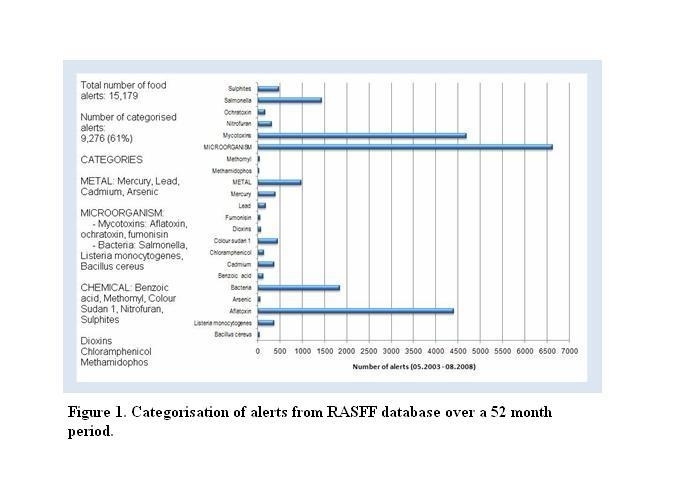
While microorganisms constitute the largest group of alert categories, it is notable that annual alerts for this category broadly remain constant despite seasonal fluctuations (Figure 2). Over the 52 month period, the average level of metal alerts doubled.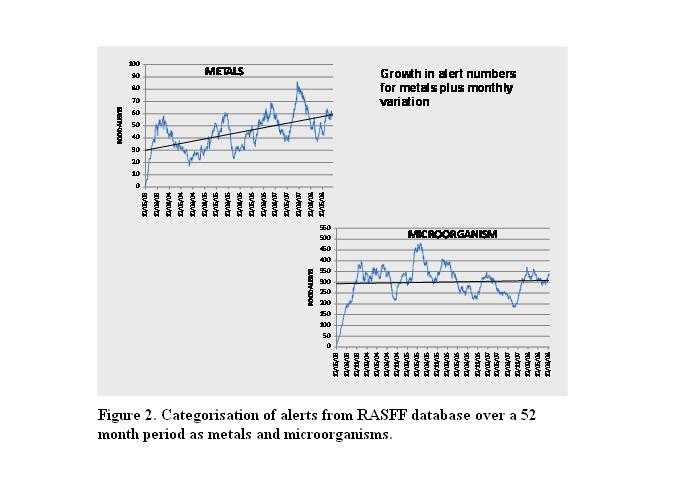
Metal alerts over an 11 month period
As reported previously by the authors, alerts for heavy metal ions in seafoods are subject to variances based upon type of metal, country reporting, type of seafood and season. Within the dataset used, 82% of all heavy metal alerts arise from seafoods and predominantly in the summer months, with some 72% being from Hg, 25% as Cd and 3% as Pb[2]. Further analyses revealed that shark and swordfish accounted for ~ 74% of Hg contamination with Spain being the predominant producer of Hg contaminated seafood (Figure 3). A very different pattern was observed for cadmium contamination of seafood where it was mainly found in anchovies, prawns, scallops, sardines, crab and squid. In contrast Pb was mainly found in clams, mussels and prawns[2].
It is notable that heavy metals like Cd, Hg and Pb in seafoods are a cause for concern despite the levels found. However, pattern appear in the 11 month dataset revealing that alerts arising from seafood originating in some countries tended to have higher concentrations of heavy metals (Figures 4 & 5). For example for Cd, levels varied greatly with those from France having a high mean range along with a large standard deviation (Figure 4).
Across the three seasons, Cd consistently showed wide variations compared to the Hg and Pb levels (Figure 6).
Network approach
An interactive visualisation tool has been developed to enable rapid access to information about the patterns of food alerts over a wide range of parameters: reporting countries, reported countries, extent of reporting activity and networks in reporting at the country level. The results are visualized in an interactive graph affording great transparency of all food report connections for a selected time period. It facilitates user friendly analyses of the large dataset based on interactions between countries. Figure 7 depicts the complexity of a network map of countries reporting and reported contamination of food produce. The direction of the arrows represents the activity (pointing toward a country that is reported on) with their thickness representing the tie-strength.
This complex map can be simplified and countries’ activities compared by the network approached given here (Network approach to investigate food alert patterns for metal contamination analyses in seafoods) . This network tool also allows detecting underlying patterns of food alerts for a selected time, country or frequency of reports between two countries (expressed as tie strength). Countries’ performance as transgressors and detectors can be compared and visualised (Figure 8). Further work is underway to include further selection options such as type of contamination or type of food.
Details on this recently published network tool for analysing global food reports based on the RASFF system is available on open access [4]. The tool is available via the following link: http://staffnet.kingston.ac.uk/~ku36087/foodalert/.
Conclusions
To date, our published reports demonstrate
- trends and patterns in seafood contamination with heavy metals [2],
- the first application of a network analysis tool to studying global food alerts for heavy metals [3], and
- the first user friendly “free to use” network analysis tool to reveal food alert patterns between nations over a 52 month period [4].
Further Reading
- Anonymous, 2007 High-Level International Food Safety Forum adopts the Beijing Declaration on Food Safety. World Health Organization (2007) Switzerland.
- Naughton, D.P., and Petroczi, A. (2009) Mercury, cadmium and lead contamination in seafood: a comparative study to evaluate the usefulness of Target Hazard Quotients. Food and Chemical Toxicology, 47, 298-302.
- Nepusz, T., Petroczi, A., and Naughton, D.P. (2009) Food recall patterns for metal contamination analyses in seafoods: longitudinal and geographical perspectives. Environment International, 35, 1030-1033.
- Nepusz, T., Petroczi, A., and Naughton, D.P. (2009) Network analytical tool for monitoring global food safety highlights China. PloS ONE 4(8): e6680. doi:10.1371/journal.pone.0006680.
- Nepusz, T., Petroczi, A., and Naughton, D.P. (2008)Worldwide food recall patterns over an eleven month period: A country perspective. BMC Public Health, 8, 308.
- Csárdi, G., and Nepusz, T. (2006) The igraph software package for complex network research. InterJournal Complex Systems, p. 1695.
